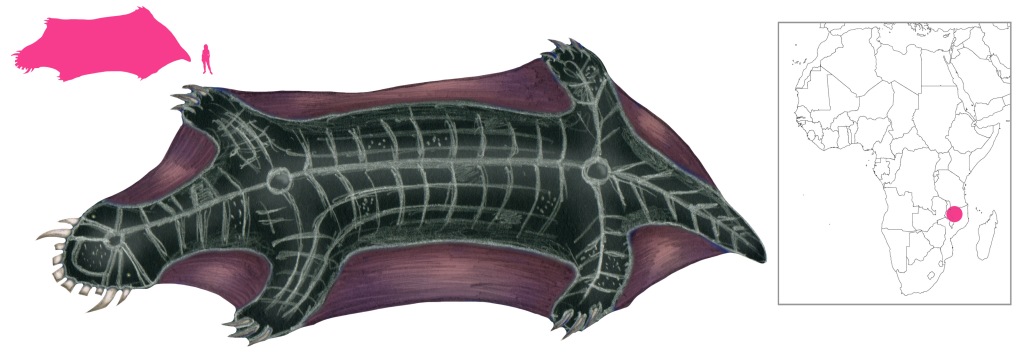Variations: Nalumgumi; Liporo (possibly); Napolo (possibly)

The Namungumi or Nalumgumi, usually translated to “whale”, features in the initiation ceremonies of the Yao people of Malawi, Mozambique, and Tanzania.
Despite the “whale” designation, the namungumi pictured in the inyago ceremonies has four limbs. There is a stylized and ornamental webbing drawn between the limbs, and there are two knobs marking the juncture of the neck with the forelimbs and tail with the hindlimbs respectively. It has prominent tusks around its head. The entire body is crisscrossed with a complex grid pattern.
The namungumi lives in Lake Malawi. It would surface near a village, and the people could come and carve off chunks of meat from its vast body. This action was painless and the wounds healed immediately. The meat itself tasted different depending on where it came from – some areas on the namungumi’s body produced choice cuts, while others were practically inedible.
As an initiatory figure the namungumi represents water and kinship.
A similar creature, the Liporo of the Anyanja, is not as large. Its habits include killing hippos and tipping canoes. It is believed to be extinct. The Napolo is a similar flood-related water serpent.
References
Morris, B. (2000) Animals and Ancestors: An Ethnography. Berg Publishers, Oxford.
Stannus, H. (1919) The Wayao of Nyasaland. Harvard African Studies, Cambridge, Massachusetts.
Now this is a beast that truly feels mythical. Is its appearance entirely based on the glass lantern slide in the Tate, or is there a physical description in the books?
LikeLiked by 1 person
Physical description is based on the drawings, it’s described as such.
LikeLiked by 1 person
Well I’m loving it!
LikeLiked by 2 people
There’s also a more detailed drawing in my sources that shows the fangs and such.
LikeLiked by 2 people
It’s always funny and sad when a mythical being is described as extinct. Feels like the modern world can cull even our imaginations.
LikeLiked by 3 people
Where’s the head?
LikeLiked by 2 people
It’s the end with the teeth, obviously
LikeLiked by 2 people